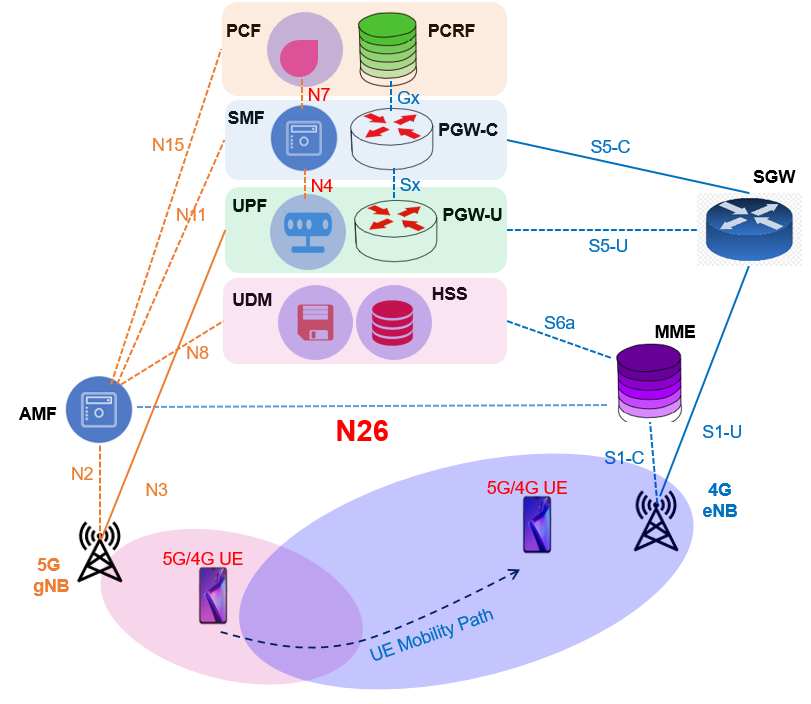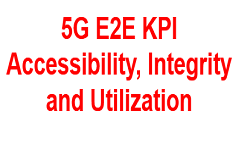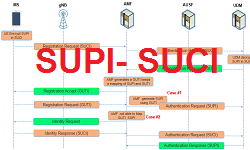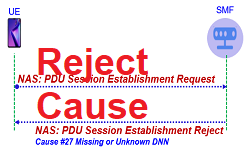5G N26 Interface – 5G to 4G Interworking
N26 interface Introduction
N26 interface is an interface which interconnects the 5G Core network function AMF with 4G network node MME and enables interworking between 5G to 4G and visa versa.
N26 interface is used to transfer UE’s authentication and session context as the UE moves between the 5GS and 4G-EPS systems. The support for N26 interface between AMF in 5GC and MME in EPC is required to enable seamless session continuity for inter-system handover which will be critical for voice services. For example, if a Voice call is initiated in 5G NR i.e VONR call can be continued when there is an Inter-RAT handover to LTE and the voice call be continued as a VoLTE Call.
Key Pointers
- N26 is the interface between 5G AMF and 4G MME
- N26 interface is based on GTPv2 instead of Httpv2 which is known for 5G Service Based Architecture
- It enables interworking between 5G and 4G to support Inter-RAT mobility
- N26 interface support seamless session continuity for Voice and Data during inter-RAT handover (5G to 4G and 4G to 5G)
- N26 enables the exchange of Mobilty Management and Session Management states between the source and target network
- N26 interface support is optional at MME and AMF
- N26 interface availability reduces the latency during Inter-RAT procedures
- N26 interface can reduce interruption time <300 ms and without N26 interface the interrupton time could be aroud 800 ms to 3 sec
- With N26 interface the UE operates with single-registration mode and without N26 UE operates with dual-registration mode
Interworking Architecture with N26
The network architecture for interworking between 5G and 4G using N26 is shown in following figure. Here we can see N26 interface between 5G AMF and 4G MME. It can be considered as the control plane interface.

In this architecture, we shall consider following intergations point for successful N26 Interface based Interworking:
-
- AMF and MME should be connected through the N26 interface and performs the registration procedure with HSS and UDM to maintains the context for the UE.
- UDM and HSS should be able to interconnect with each other and exchange the subscription data for the UE when the UE moves between 5G and 4G.
- PGW-C and SMF node should be able to maintain mapping between the PDN connection and PDU session-related parameters, including APN to DNN mapping, APN-AMBR to session AMBR mapping, QoS mapping in 4G to 5QI mapping in 5G and PDU session type mapping.
- The PCF and PCRF should be able to exchange UE-related policies to provide seamless mobility between the 5G and 4G networks
Interworking with N26 Support Indicator
- Case#1 – UE Connecting to 5GS
When UE is connecting to 5G and sends Registration Request including S1 Mode support, the AMF supporting interworking with EPS shall set the Interworking N26 bit to either of follwoing within Registration Accept Message in the 5GS network feature support IE:
-
- Interworking without N26 interface not supported, when 5G AMF supports N26 interface
- Interworking without N26 interface supported, when 5G AMF does not support the N26 interface

- Case#2 – UE Connecting to 4G-EPS
When UE is connecting to 4G-EPS and sends Attach Request indicating support for N1 mode, then MME supporting inter-system interworking with 5GS can set the Interworking N26 bit to either of follwoing within Attach Accept Message in EPS network feature support IE.
-
- Interworking without N26 not supported, When MME does not support interworking procedures without N26 interface
- Interworking without N26 supported, When MME supports interworking procedures without N26 interface
Idle and Connected Mode Mobility Over N26
- Idle Mobility case – Cell Reselection
- When the UE is in RRC-Idle mode under a 5G Cell and move from 5GS to MME, AMF tansfers the MM context (UE Usage type) to MME
- When the UE is in RRC-Idle mode under a 4G Cell and move from MME to 5GS, MME tansfers the S-NSSAIs associated with the PDN connections and mapping info to AMF.
- Connected Mobility – Handover
- When UE is RRC-Connected mode under a 5G Cell and move from 5GS to MME, AMF selects the target MME (based on Source AMF region ID, AMF set ID and target location) and transfers the UE context over N26 interface. After the HO successful, Tracking Area Update is performed.
- When UE is RRC-Connected mode under a 4G Cell and move from MME to 5GS, MME selects the target AMF based on the target location (TAI or any other local info) and transfers the UE context over N26 interface. The PGW-C and SMF sends PDU Session IDs and related S-NSSAIs to AMF. After the HO successful, Registration is performed to secure the allowed N-SSAI.
N1 Mode and S1 Mode Defination
- N1 mode: In N1 mode UE is allowed to access to 5G core network via the 5G access network
- S1 mode: with S1 Mode, there is a single UE’s usage setting at the UE which applies to both 5GS and EPS
Requirements to support Interworking with N26 Interface
5G AMF and 4G MME has to supports the following procedures to enable Interworking using N26 interface:
-
- Attach and Registration procedure
- EPS to 5GS Mobility Registration procedure
- 5GS to EPS Idle mode mobility procedure
- 5GS to EPS Handover
- EPS to 5GS Handover
- 5GS to EPS Handover Cancel
- EPS to 5GS Handover Cancel
References:
- 3GPP TS 23.501 : System architecture for the 5G System (5GS
- 3GPP TS 23.502 : Procedures for the 5G System (5GS)
- 3GPP TS 33.501 : Security architecture and procedures for 5G System
- 3GPP TS 24.301 : Non-Access-Stratum (NAS) protocol for Evolved Packet System (EPS)
- 3GPP TS36.413 : S1 Application Protocol (S1AP)
Related Posts:
- 5G AMF – Access and Mobility Management Function
- Voice over NR Call Flow
- 5G PDU Session and Its Types
- 5G Reference Network Architecture
- Hybrid Core Network – 4G Core to 5 G Core Interconnection



